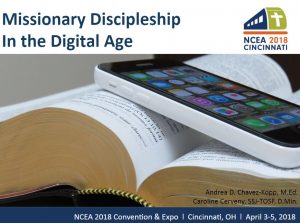 One of our staff recently attended the National Catholic Education Convention in Cincinnati, Ohio. The following is a summary of one of the seminars attended:
One of our staff recently attended the National Catholic Education Convention in Cincinnati, Ohio. The following is a summary of one of the seminars attended:
Speakers Caroline Cerveny MA, CMin and Andrea Chavez-Kopp from NCEA presented an interactive seminar discussing the challenges and opportunities that digital tools have created from a faith perspective and described the NCEA Digital Discipleship programme, which can be relevant for NZ schools and parishes in that it outlines the different types of digital engagement for people of faith. The seminar began with a quiz asking attendees to use their phones to answer about six brief questions about how often they use digital technology, types of social media platforms they use and in what capacity they use digital tools in regards to prayer and with students.
“It was the best of times, it was the worst of times”
The group discussed how life has become easier but we’re at risk of becoming dependent on digital technology. We’re more connected but we still can’t communicate. We tend to stick with people who agree with us and isolate ourselves from diversity of opinion. Everything is fragmented/spread-out, rather than deep/meaningful. It gives us the opportunity to make lessons that are transformative. Digital technology supports the notion of universal access.
Some of the challenges the group covered were cost/access, the distraction digital technology creates, safety and appropriateness of content; fear of not keeping up with parents, and students and not being the expert; liability for organisations; policy implications for organisations; privacy concerns; health and addiction risks.
The presenters then asked if communication and language is becoming a lost art? Is written communication more or less valid than digital communication? Letter writing takes more time and consideration and has a tactile element; letters on paper can contain personal handwriting and perfume. A letter is very private; there are privacy risks with anything online. The audience was asked to consider the value assignation between letters and digital content. We assign a higher value to letter/written content, what impact does this have?
The most watched content on the internet does not align with our Catholic values – the top subscribed content does not include Catholic theologians! – so, do we have policy that limits access to the internet whether in homes, schools, youth groups etc? As ministers we are encouraged to “accompany/meet people where they are”. How can we achieve that if we don’t walk alongside their activities/mediums. We need to work with them to build faith skills and connect on social justice. Technology is absolutely the way to do that.
If you don’t like what’s being said, change the conversation. We need to produce content so that we are having a digital presence and providing resources for digital users of faith.
Resources: Common Sense Media (used to help teach children to help discern content), ISTE, Digital Discipleship Competences for Ministry (adapting ISTE standards):
The Digital Discipleship Competencies programme describes six steps to becoming a Digital Disciple:
1) Digital Citizenship: is about recognising your safety, etiquette and privacy responsibilities when using digital tools.
2) A Digital Curator: understanding the bias/perspective of what I’m reading or what I write. Everybody has different opinions, what is important is that as you communicate you get closer to one another. Understanding perspective and listening to one another.
3) Community Discipleship: if you’re going to use social media, be aware of your network and who you influence and get out of your comfort zone and share something inspirational, perhaps something about your faith – e.g. asking what your friends would like you to pray for.
4) Digital Communicator: there are a range of digital tools available which people can use to share negative and positive feedback; share positive feedback knowing that younger people pay attention.
5) Mobile Evangelisation and Catechesis: utilising Catholic apps and tools, sharing information, strategically sharing and engaging with families about digital tools. E.g. the app Laudate, the Catholic News Agency etc.
6) Collaborative Disciple: using digital tools to collaborate or sharing tools that can be used. Church groups operate in silos, digital tools can breakdown the silos.
Pope Francis is inviting us to be disciples in ways we’ve never thought about; digital tools are an example. The digital world is a new place and a new land, we just have to learn to navigate it. Digital tools can change instructional design – such as more peer evaluation.
Finally, the presenters shared the results of the audience profile quiz – most attendees spent 8-12 hours per day in front of screens; 75% use technology with students; 80% using digital media to share about their faith; 70% tell us they have not checked text messages during Mass!
Author note: this presentation was accompanied by slides, click here for a PDF copy. For advice about online safety in New Zealand, visit Netsafe.
